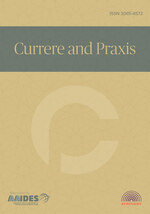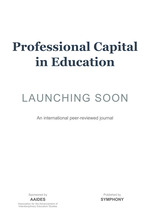Students speak: Academic, career, and sociocultural experiences of African American college students
DOI:
https://doi.org/10.70116/2980274120Keywords:
Racial and educational equity, persisting educational issues, access, inclusivity, African American studentsAbstract
This manuscript presents the outcomes of a qualitative research investigation centered on the experiences of African American college students in terms of their preparation for high school, college, and careers within a Predominantly White Institution (PWI) situated in rural southeastern Wisconsin. At the time of this research, the comprehensive public university had an undergraduate enrollment of 10,196 students. Among these students, 82.1% self-identified as White, 7.8% as Hispanic or Latinx, 5.4% as African American, 3.2% as Asian or Southeast Asian, and 0.9% as American Indian or Alaskan Native. Using semi-structured interviews with willing student participants, the primary objectives of this study were twofold: (1) to recognize the sociocultural and institutional elements that influence the career trajectories of African American students attending the institution and (2) to effectively capture the educational and career viewpoints and voices of these students as they navigate the complex sociocultural and institutional landscape. Key findings from the research highlight the students’ perspectives on the substantial connections between their high school experiences, particularly those in and around a major urban center in the Midwest, and their subsequent college and career paths. Additionally, the study underscores the challenges these students encounter while navigating the physical and social spaces on a rural PWI campus. Recommendations are made for creating a more welcoming space for African American students and for supporting those engaged in the work.
Downloads
References
Abdi Z. S. (2021). Predicting occupational consideration by interest, self-efficacy, and outcome expectations in students. Preventive Counseling, 1(3), 50-60.
Adams, T. L., & McBrayer, J. S. (2020). The lived experiences of first-generation college students of color integrating into the institutional culture of a predominantly white institution. The Qualitative Report, 25(3), 733-757.
Alvarez, A., Blume, A., Cervantes, J., & Thomas, L. (2009). Tapping the wisdom tradition: Essential elements to mentoring students of color. Professional Psychology: Research and Practice, 40(2), 181–188.
Basha, R. (March 2016). Students and law enforcement talk race relations at policing forum. The Michigan Daily. Retrieved 1 November, 2023 from https://www.michigandaily.com/news/students-and-law-enforcement-come-together-policing-forum/
Benbow, R., Toms, O., Arman, L., Chughtai, M., Pasqualone, A., Vivona, B., & Wolfgram, M. (2020). Engaging college students of color in higher education policy studies and advocacy. Retrieved 21 December, 2023 from https://ccwt.wisc.edu/wp-content/uploads/2022/04/ccwt_report_Engaging-college-students-of-color-in-higher-education-policy-studies-and-advocacy.pdf
Boostrom, R. (1998). “Safe space”: Reflections on an educational metaphor. Journal of Curriculum Studies, 30(4), 397–408. https://doi.org/10.1080/002202798183549
Brass, D. J. (1984). A structural analysis of individual influence in an organization. Administrative Science Quarterly, 29(4), 518-539.
Braun, V., & Clarke, V. (2006). Using thematic analysis in psychology. Qualitative Research in Psychology, 3(2), 77-101. https://doi.org/10.1191/1478088706qp063oa
Braun, V., & Clarke, V. (2006). Using thematic analysis in psychology. Qualitative Research in Psychology, 3(2), 77-101. https://doi.org/10.1191/1478088706qp063oa
Burt, R. S. (1992). Structural holes: The social structure of competition. Harvard University Press.
Byars-Winston, A., Rogers, J. G., Thayer-Hart, N., Black, S., Branchaw, J., & Pfund, C. (2023). A randomized controlled trial of an intervention to increase cultural diversity awareness of research mentors of undergraduate students. Science Advances, 9(21), 1-11.
Coleman, J. S. (1988). Social capital in the creation of human capital. American Journal of Sociology, 94, 95-120.
Cote, R. (2019). The evolution of social network theory: Perceived impact on developing networking relationships. American Journal of Management, 19(3), 19-34.
Deng, X., Fernández, Y., & Zhao, M. (2022). Social media use by first-generation college students and two forms of social capital: A revealed causal mapping approach. Information Technology & People, 35(1), 344-366.
Gooden, S., Evans, L., & Pang, Y. (2018). Making the invisible in nonprofit courses: A case study of African American-led nonprofits. Journal of Public Affairs Education, 24(4), 490-517. https://doi.org/10.1080/15236803.2018.1488485
Granovetter, M. S. (1973). The strength of weak ties. American Journal of Sociology, 78(6), 1360-1380. Retrieved from https://www.jstor.org/stable/2776392
Greer, T. M., & Chwalisz, K. (2007). Minority-related stressors and coping processes among African American college students. Journal of College Student Development, 48(4), 388-404.
Griffith, A. N., Hurd, N. M., & Hussain, S. B. (2019). “I didn’t come to school for this”: A qualitative examination of experiences with race-related stressors and coping responses among Black students attending a predominantly White institution. Journal of Adolescent Research, 34(2), 115-139.
Harwood, S. A., Huntt, M. B., Mendenhall, R., & Lewis, J. A. (2012). Racial microaggressions in the residence halls: Experiences of students of color at a predominantly White university. Journal of Diversity in Higher Education, 5(3), 159-173.
Harwood, S. A., Mendenhall, R., Lee, S. S., Riopelle, C., & Huntt, M. B. (2018). Everyday racism in integrated spaces: Mapping the experiences of students of color at a diversifying predominantly white institution. Annals of the American Association of Geographers, 108(5), 1245-1259.
Jama, P. M., Beylefeld, A. A., & Monnapula-Mapesela, M. (2009). Theoretical perspectives on factors affecting the academic performance of students. South African Journal of Higher Education, 22(5), 992-1005.
Law, K. L., Guthrie, D., Beaver, B. R., Johnson, S. M., Parys, J., & Toms, O. M. (2019). Faculty and staff perceptions of undergraduate mentoring. Mentoring & Tutoring: Partnerships in Learning. https://doi.org/10.1080/13611267.2019.1649918
Lopez-Littleton, V. (2016). Critical dialogue and discussions of race in the Public Administration classroom. Administrative Theory & Praxis, 38(4), 285-295. https://doi.org/10.1080/10841806.2016.1242354
Lopez-Littleton, V., Blessett, B., & Burr, J. (2018). Advancing social justice and racial equity in the public sector. Journal of Public Affairs Education, 24(4), 449-468. https://doi.org/10.1080/15236803.2018.1490546
Maldonado, V. M. (2022). Influence of the Upward Bound Program on select low-income, first-generation college students’ aspirations to enroll in postsecondary education (Unpublished doctoral dissertation). Sam Houston State University, Huntsville, TX.
Merriam, S. B., & Tisdell, E. J. (2016). Qualitative research: A guide to design and implementation. John Wiley & Sons.
Mills, K. J. (2020). “It’s systemic”: Environmental racial microaggressions experienced by Black undergraduates at a predominantly White institution. Journal of Diversity in Higher Education, 13(1), 44-55.
Monjaras-Gaytan, L. Y., & Sánchez, B. (2023). Historically underrepresented college students and natural mentoring relationships: A systematic review. Children and Youth Services Review, 149, 1–9. https://doi.org/10.1016/j.childyouth.2023.106965
Museus, S. D. (2008). The role of ethnic student organizations in fostering African American and Asian American students’ cultural adjustment and membership at predominantly White institutions. Journal of College Student Development, 49(6), 568-586.
Newkirk, D. (2022). Parenting and the academic success of Black males: A qualitative study. (Unpublished doctoral dissertation). Capella University, Minneapolis, MN.
Offidani-Bertrand, C., Velez, G., Benz, C., & Keels, M. (2022). “I wasn’t expecting it”: High school experiences and navigating belonging in the transition to college. Emerging Adulthood, 10(1), 212-224.
Parks-Yancy, R. (2012). Interactions into opportunities: Career management for low-income, first-generation African American college students. Journal of College Student Development, 53(4), 510-523.
Rozek, C. S., & Gaither, S. E. (2020). Not quite white or black: Biracial students’ perceptions of threat and belonging across school contexts. The Journal of Early Adolescence. https://doi.org/10.1177/0272431620950476
Saldaña, J. (2015). The coding manual for qualitative researchers. Sage.
Storlie, C. A., Hilton, T. L., Duenyas, D., Archer, R., & Glavin, K. (2018). Career narratives of African American female college students: Insights for college counselors. Journal of College Counseling, 21(1), 29-42.
Strayhorn, T. L. (2011). Bridging the pipeline: Increasing underrepresented students’ preparation for college through a summer bridge program. American Behavioral Scientist, 55(2), 142-159.
Tichavakunda, A. A. (2020). Studying Black student life on campus: Toward a theory of Black placemaking in higher education. Urban Education, 59(1), 96-123. https://doi.org/10.1177/0042085920971354
U.S. Department of Education, National Center for Education Statistics. (2019). Digest of education statistics. Retrieved 4 November, 2023 from https://nces.ed.gov/programs/coe/indicator_cpb.asp and https://nces.ed.gov/programs/digest/d19/tables/dt19_326.15.asp?current.asp
Downloads
Published
How to Cite
Issue
Section
License
Copyright (c) 2024 Symphony

This work is licensed under a Creative Commons Attribution 4.0 International License.














